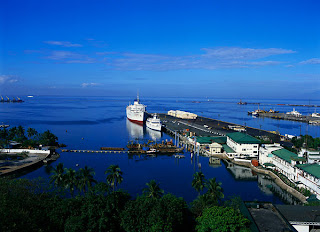Coupon taxi or yellow taxi from Manila airport ?
I'm a female solo traveller arriving at 11:50 at night at Terminal 3. Would like to know if coupon taxi is still available at airport. I feel this is a safer option for me to take to my hotel in Paranaque. Another option would be hotel pick-up if available. Any suggestion is much appreciated. Salamat guid.
- Coupon and yellow taxis are available 24 hrs a day at all terminals
- The taxi details will be recorded by the taxi dispatsher. Don't worry - you will be safe.
- I favor the coupon taxi (glad they're still available) as the rate is fixed according to destination. Tho both are reliable and safe, my experience with yellow airport taxi drivers in the past hasn't been pleasant. Thanks again.
- Coupon taxi rates is around 440pesos for the outermost part of paranaque.
- Correct me I am wrong. When I was in T3, I can't find any yellow taxi but I can find white metered taxi.
- During our visit in January this year, I do remember taking a white taxi from the airport. The driver had mentioned that he had to have new meter installed (a govt. requirement and quite
expensive, too). Altho he said that he had it on, we were unable to see the meter from where we were seated in the back. Even with us knowing where the hotel is located (Tambo, Paranaque, a 10-15 min taxi ride at around midnite), it still cost us 500 pesos (his big smile is worth it!).
At least with coupon taxi, the exact fare is shown altho a tip is still expected.
- To mousehunt: That's odd, I know that the ordinary white metered taxis are not allowed at Terminal 3 except for a few if I'm not mistaken. I know that Terminal 3 is a haven of yellow airport taxis as they have a garage at Terminal 3.
I agree that the coupon taxi is more reliable than the yellow airport taxi as you already know how much you're going to pay before you arrive at your destination. It is wiser to use the coupon taxi during rush hour as even you are stuck in traffic for an hour you don't have to pay anything more than what is agreed upon.
- I always use T3 and the only available cabs are the airport yellow taxis. Havent had any bad expereience with them yet, though more expensive, you dont really have a choice.
- Coupon taxi are always more expensive than yellow taxi. To get to Makaki, it was about 200 pesos more than yellow.....go with Yellow taxi...even taxi..will not cost that much more with a meter. Also, for longer trips, lets say to Angeles, you can negotiate with Yellow..you can NOT with Coupon. We got a yellow to Angeles, Airport for P2000...more than once.
Coupon taxi or yellow taxi from airport
I'm a female solo traveller arriving at 11:50 at night at Terminal 3. Would like to know if coupon taxi is still available at airport. I feel this is a safer option for me to take to my hotel in Paranaque. Another option would be hotel pick-up if available. Any suggestion is much appreciated. Salamat guid.
- Coupon and yellow taxis are available 24 hrs a day at all terminals
- The taxi details will be recorded by the taxi dispatsher. Don't worry - you will be safe.
- I favor the coupon taxi (glad they're still available) as the rate is fixed according to destination. Tho both are reliable and safe, my experience with yellow airport taxi drivers in the past hasn't been pleasant. Thanks again.
- Coupon taxi rates is around 440pesos for the outermost part of paranaque.
- Correct me I am wrong. When I was in T3, I can't find any yellow taxi but I can find white metered taxi.
- During our visit in January this year, I do remember taking a white taxi from the airport. The driver had mentioned that he had to have new meter installed (a govt. requirement and quite
expensive, too). Altho he said that he had it on, we were unable to see the meter from where we were seated in the back. Even with us knowing where the hotel is located (Tambo, Paranaque, a 10-15 min taxi ride at around midnite), it still cost us 500 pesos (his big smile is worth it!).
At least with coupon taxi, the exact fare is shown altho a tip is still expected.
- To mousehunt: That's odd, I know that the ordinary white metered taxis are not allowed at Terminal 3 except for a few if I'm not mistaken. I know that Terminal 3 is a haven of yellow airport taxis as they have a garage at Terminal 3.
I agree that the coupon taxi is more reliable than the yellow airport taxi as you already know how much you're going to pay before you arrive at your destination. It is wiser to use the coupon taxi during rush hour as even you are stuck in traffic for an hour you don't have to pay anything more than what is agreed upon.
- I always use T3 and the only available cabs are the airport yellow taxis. Havent had any bad expereience with them yet, though more expensive, you dont really have a choice.
- Coupon taxi are always more expensive than yellow taxi. To get to Makaki, it was about 200 pesos more than yellow.....go with Yellow taxi...even taxi..will not cost that much more with a meter. Also, for longer trips, lets say to Angeles, you can negotiate with Yellow..you can NOT with Coupon. We got a yellow to Angeles, Airport for P2000...more than once.
Coupon taxi or yellow taxi from airport
I'm a female solo traveller arriving at 11:50 at night at Terminal 3. Would like to know if coupon taxi is still available at airport. I feel this is a safer option for me to take to my hotel in Paranaque. Another option would be hotel pick-up if available. Any suggestion is much appreciated. Salamat guid.
- Coupon and yellow taxis are available 24 hrs a day at all terminals
- The taxi details will be recorded by the taxi dispatsher. Don't worry - you will be safe.
- I favor the coupon taxi (glad they're still available) as the rate is fixed according to destination. Tho both are reliable and safe, my experience with yellow airport taxi drivers in the past hasn't been pleasant. Thanks again.
- Coupon taxi rates is around 440pesos for the outermost part of paranaque.
- Correct me I am wrong. When I was in T3, I can't find any yellow taxi but I can find white metered taxi.
- During our visit in January this year, I do remember taking a white taxi from the airport. The driver had mentioned that he had to have new meter installed (a govt. requirement and quite
expensive, too). Altho he said that he had it on, we were unable to see the meter from where we were seated in the back. Even with us knowing where the hotel is located (Tambo, Paranaque, a 10-15 min taxi ride at around midnite), it still cost us 500 pesos (his big smile is worth it!).
At least with coupon taxi, the exact fare is shown altho a tip is still expected.
- To mousehunt: That's odd, I know that the ordinary white metered taxis are not allowed at Terminal 3 except for a few if I'm not mistaken. I know that Terminal 3 is a haven of yellow airport taxis as they have a garage at Terminal 3.
I agree that the coupon taxi is more reliable than the yellow airport taxi as you already know how much you're going to pay before you arrive at your destination. It is wiser to use the coupon taxi during rush hour as even you are stuck in traffic for an hour you don't have to pay anything more than what is agreed upon.
- I always use T3 and the only available cabs are the airport yellow taxis. Havent had any bad expereience with them yet, though more expensive, you dont really have a choice.
- Coupon taxi are always more expensive than yellow taxi. To get to Makaki, it was about 200 pesos more than yellow.....go with Yellow taxi...even taxi..will not cost that much more with a meter. Also, for longer trips, lets say to Angeles, you can negotiate with Yellow..you can NOT with Coupon. We got a yellow to Angeles, Airport for P2000...more than once.

















